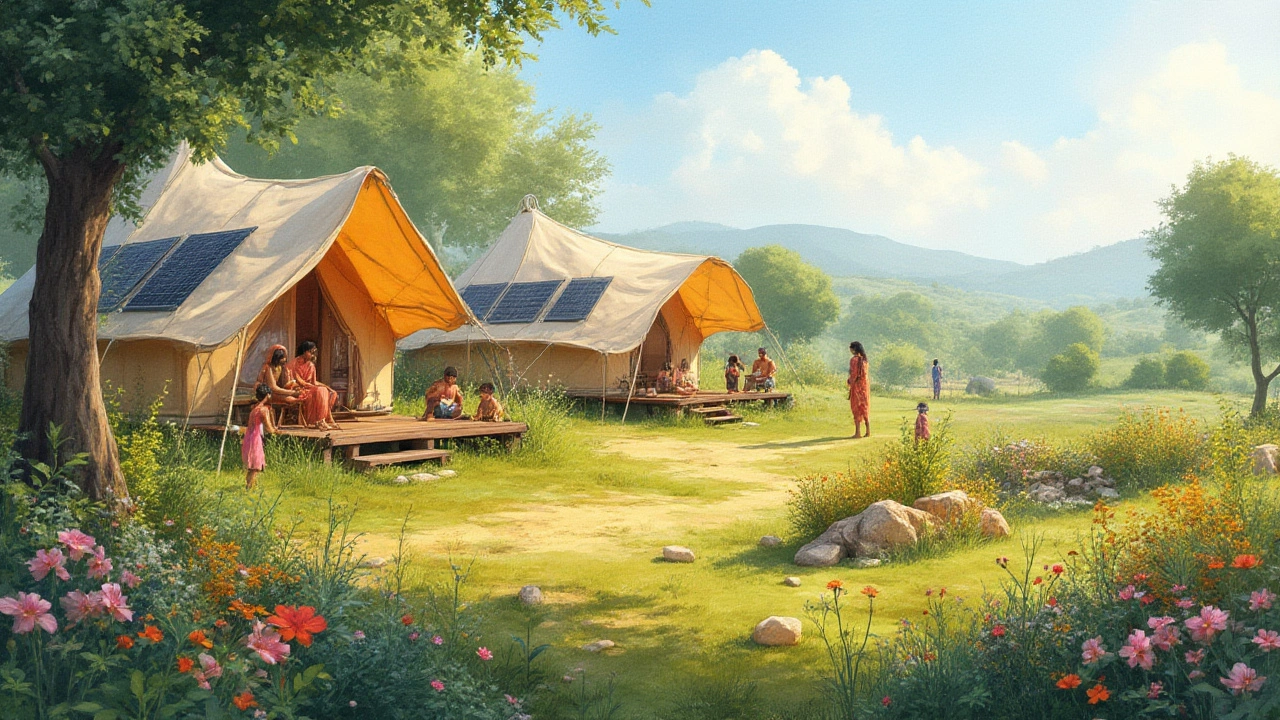Picture this: You’re lounging in a cozy, canvas tent with a real bed, sipping fair-trade coffee, the birds are making their usual racket, but your phone's on airplane mode. Is this pure indulgence, or is it actually a win for the planet? Glamping—the glamorous cousin of rough-and-tumble camping—sounds like a green dream. It promises nature, comfort, and minimal impact, all wrapped up in a chic design with maybe a hot tub thrown in. But does it really deliver on those eco-friendly promises, or is it just clever branding? There’s a lot more beneath the canvas than Instagram lets on.
The Green Claims of Glamping: Hype or Honest?
On paper, glamping looks like the poster child for sustainable travel. Operators often shout about composting toilets, solar fairy lights, and “off-grid” credentials. The idea is simple: You’re getting away from concrete hotels, avoiding long-haul flights (maybe), and supposedly melting into nature without trashing it. The earliest glamping setups were genuinely low-impact—think yurts or bell tents with fire pits, tucked in a quiet field. But bigger demand brought bigger business. Now, some glamping sites are more like resorts, with power showers, heated floors, minibars, and even WiFi beamed in by satellite. This blurs the line between a nature escape and yet another energy-hungry hotel.
It helps to look for actual data, not just marketing. According to a 2023 UK study by Green Escape, glamping setups using solar energy and composting toilets scored drastically lower (about 35% less) in CO2 emissions per night than traditional hotel stays. But—and it’s a big but—glampsites with fixed wooden cabins or those running generators wiped out nearly all those gains. So not all glamping is built the same.
Here’s the sneaky part: Some places advertise “eco-friendly luxury” but install permanent structures, tap into municipal water, and recycle less than your average corner café. Meanwhile, others go the extra mile with zero-waste policies, hyper-local materials, and actual wildlife restoration. The lesson? Look past the word "eco." Ask about energy, building materials, and waste before you book.
Eco Footprint: Telling Facts and Hidden Costs
There’s no sugarcoating it—any holiday has an environmental price tag, glamping included. Even low-impact accommodation can add up when a spot becomes popular. Remember, a field that sees a hundred tents a year isn’t the same as private farmland with ten yurts, reused water, and wildflower planting. The most honest glampsites measure their actual resource use. For example, some operators, like Feather Down Farms, keep their water use below 30 liters per guest per day—about a fifth of the average hotel figure in the UK. Others sink rainwater tanks and use reclaimed timber for all construction, not just the marketing photos.
Then there’s the travel factor. If you’re driving three hours in a diesel 4x4 to reach your off-the-grid tent, that’s a big dent in your environmental scorecard. On the other hand, spots within easy reach by train or bus, or places with shuttle bikes, help tip the scales the other way. Actually, a University of Exeter survey found that nearly 40% of glampers in England chose sites accessible by public transport, cutting trip emissions before even pitching a tent.
The “hidden” costs to wildlife are real, too. Light pollution from fancy outdoor lighting can disturb birds and insects. Some badly designed glampsites have trampled wild meadows, pushing out rare flowers. That’s why the best sites keep numbers low, move tents seasonally, or partner with botanists to restore habitats. If sustainability matters to you, these are questions worth asking before flicking through the site gallery.

How to Spot Truly Eco-Friendly Glamping
If you care about your footprint when you travel, there are clear ways to sort the genuine green getaways from the greenwashed. First up: certifications. Labels like Green Key, Eco Tourism Gold, or The Green Tourism Award don’t guarantee perfection, but they’re better than nothing. These usually demand real proof—on-site renewable energy, clear waste management plans, and chemical-free cleaning. When you’re browsing, see if the site tells you exactly what they do: details matter, like “grey water recycling system” or “all electricity from wind power” versus just a vague “sustainable approach.”
The most authentic stays are usually small, owner-run, and excited to talk about what they’re doing behind-the-scenes. I’ve personally messaged at least a dozen places asking about their heating, waste policies, and water, and the best ones will send photos of their worm bins or explain how they just swapped all soap dispensers for plastic-free refills. If you read reviews that mention real, functioning eco efforts (or any issues), take them seriously.
Materials matter. Tents made from heavy PVC aren’t remotely as green as cotton canvas or, better still, recycled materials. Look for timber sourced under FSC standards, and avoid plastic-heavy sites unless there’s a clear plan for reuse or recycling. Ask how many people they host at a time; smaller numbers usually means lighter impact—both for you and the animals living nearby.
Swaps and Tips for Greener Glamping Stays
Alright, you’ve chosen your spot, checked their credentials, and you want to do your bit as a visitor. There are simple swaps that make a difference. Pack reusable gear: bring a good water bottle, your own cup, and leave single-use stuff at home. Most eco-lodges are happy when guests use their own towels and skip over-packaged convenience foods, too. If you’re driving, try carpooling or using electric vehicles. If you can reach the site by train or bike, that’s a win for the planet and your mood.
Respect the local wildlife. It’s tempting to string lights everywhere and blast music, but animals appreciate quiet and dark nights. Instead, use solar lanterns, keep noise down, and stick to marked paths. Don’t mess with wildflowers or pick mushrooms unless your host says it’s okay. Minimize fires—most places give clear guidance—and use the provided wood rather than bringing your own, which might carry pests.
Finally, support the local economy. Buy locally sourced food, ask about farm shops, and join onsite conservation activities if offered. Some places, like Wildwood Cornwall, let guests help plant native trees or restore hedgerows—super rewarding after a glass of cider in the sunshine. Leave no trace, take your rubbish, and let your host know if you spot something unsafe or polluting on site. These little choices pile up fast.

The Verdict: Is Glamping Really Green?
So, is glamping really *eco-friendly*? In the best cases, yes—especially if you pick a site with genuine green practices, turn up using public transport, respect nature, and leave the site cleaner than you found it. But it isn’t guilt-free. There are plenty of glamping sites that promise green credentials just to ride the sustainability bandwagon, skimping on the real hard work.
Think about how you travel, not just where you sleep. The big luxury domes with dishwashers, air conditioners, and full plumbing take a bigger toll than the unassuming shepherd’s hut with a composting loo. And the glampsites that actually help restore landscapes, teach locals about ecology, and buy from right next door? They do real good while still letting you enjoy a comfy bed and a starry view.
I get why glamping appeals—my partner Ash absolutely will not sleep on a leaky foam mat, and I’d rather have a wooly blanket than shiver in a cheap sleeping bag any day. But it’s the tiny, clear, visible eco touches that make the difference: buckets for rainwater, solar chargers, wild grasses swaying around the tent, and honest hosts who care.
If you’re after the real deal, do some digging, ask awkward questions, and value substance over style. The planet, and your next wild weekend, will thank you for it.
